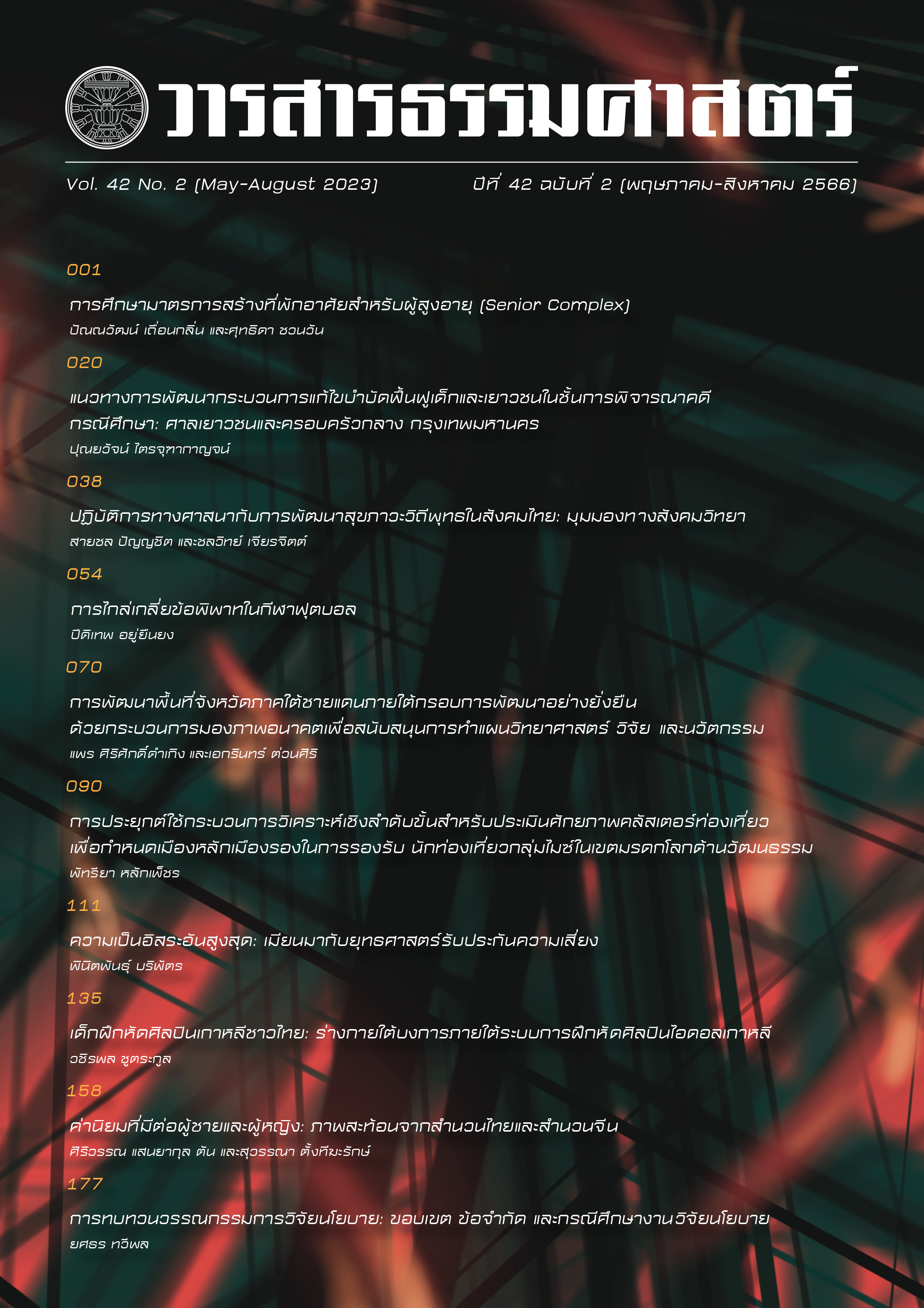Application of the Analytical Hierarchy Process (AHP) for Evaluating Potential Tourism Clusters to Identify Primary and Second Tier Cities for Supporting MICE Tourists in the World Cultural Heritage Areas
Main Article Content
Abstract
The study aims to apply an Analytical Hierarchy Process (AHP) for evaluating the potential of tourism clusters to identify primary and second tier cities for supporting the promotion of MICE tourism destinations in the cultural world heritage area. The study was conducted by quantitative analysis using a questionnaire as a research tool to collect data from a panel of 5 relevant experts. The collected data was analyzed by using the AHP Online System (AHP-OS). The finding has posited that Phitsanulok province is classified as the primary tier city (59.2%), while Tak, Sukhothai, and Kamphaengpetch provinces are classified as second tier cities (15. 7%, 14.7%, and 10.5%, respectively).
For public-private collaboration guidelines, it is suggested that educational institutions can also apply research knowledge to promote the local wisdom and provide useful advice on creating added value for tourism products and services in the unique sustainable tourism development zone, ranging from Sukhothai province, Tak Province, and Kamphaeng Phet province by raising awareness and responsibility to mitigate the
negative impacts of overall three aspects such as economic, socio-cultural and environmental aspects of tourism activities.
Article Details
References
กรมการท่องเที่ยว กระทรวงการท่องเที่ยวและกีฬา. (2559). คู่มือการบริหารจัดการแหล่งท่องเที่ยวเชิงสร้างสรรค์. กรุงเทพ : กรมการท่องเที่ยว กระทรวงการท่องเที่ยวและกีฬา.
ประภัสสร์ เทพชาตรี. (2559). ประเมินผลกระทบต่ออุตสาหกรรมไมซ์ไทยจากการ เข้าสู่ประชาคม เศรษฐกิจอาเซียน (AEC). http://dspace.library.tu.ac.th:8080/handle/ 6626133120/328?localeattribute=t
วราวุธ วุฒิวณิชย์. (2553). การตัดสินใจโดยกระบวนการวิเคราะห์ตามลําดับชั้น. ภาควิชาวิศวกรรมชลประทาน คณะวิศวกรรมศาสตร์มหาวิทยาลัยเกษตรศาสตร์วิทยาเขตกําแพงแสน นครปฐม.
สถาบันเทคโนโลยีป้องกันประเทศ. (2563). กระบวนการวิเคราะห์ตามลําดับชั้น (Analytic Hierarchy Process: AHP). https://www.dti.or.th/download/150319174753_ 3ahp4.pdf
สำนักบริหารยุทธศาสตร์กลุ่มจังหวัดภาคเหนือตอนล่าง. (2560). แผนพัฒนากลุ่มจังหวัดภาคเหนือตอนล่าง 1. http://www.osmnorth-s1.moi.go.th/indexs.html#
สำนักงานส่งเสริมการจัดประชุมและนิทรรศการ (องค์การมหาชน). (2557). อุตสาหกรรมไมซ์ในภูมิภาคเอเชีย. https://www.businesseventsthailand.com/uploads/press_ media/ file/190903-fileHVPWyZuJ1.pd
สํานักงานส่งเสริมวิสาหกิจขนาดกลางและขนาดย่อม. (2564). รายงานสถานการณ์วิสาหกิจขนาดกลางและขนาดย่อม ประจำเดือนมกราคม 2564. ฝ่ายวิเคราะห์สถานการณ์และเตือนภัยทางเศรษฐกิจ, สำนักงานส่งเสริมวิสาหกิจขนาดกลางและขนาดย่อม.
สุวิมล ติรกานันท์. (2550). ระเบียบวิธีวิจัยทางสังคมศาสตร์: แนวทางปฏิบัติ. กรุงเทพฯ: โรงพิมพ์แห่งจุฬาลงกรณ์มหาวิทยาลัย, น. 44-46.
Cochran, W. G. (1977). Sampling Techniques. (3rd ed.). New York: John Wiley & Sons. p. 203.
Goepel, K. D. (2022). AHP Online System - AHP-OS. Business Performance Management Singapore (BPMSG). https://bpmsg.com/ahp/
Porter, M. E. (1990). The competitive advantage of Nations. New York: Free Press.
Porter, M.E. (1998). On competition. Boss Ton: Harvard Business School Press.
Rowinelli, R. J., & Hambleton, R. K. (1977). On the use of content specialists in the assessment of criterion-referenced test item validity. Dutch Journal for Educational Research, 2, 49-60.
Gates, M., & Scarpa, A. (1980). Criteria for the selection of construction equipment. Journal of the Construction Division, 106(2), 207–219.

